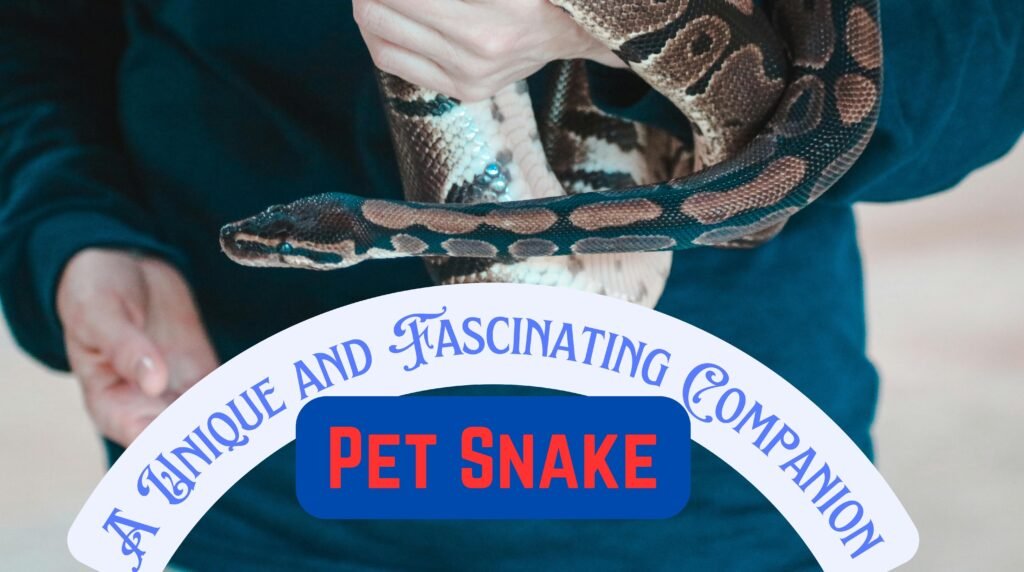Amphibians pets are fascinating, offering a touch of the wild right in your home. These cold-blooded creatures are known for their unique looks, bright colours, and interesting behaviours. If you’re considering getting an amphibian as a pet, here are 10 of the most popular choices worldwide. Each has its own charm and specific care needs.
1. Axolotl (Ambystoma mexicanum)
The Axolotl, often called the “Mexican Walking Fish,” is a unique creature that never fully grows up, keeping its youthful features for life. It has feathery gills on the outside of its body and can regrow lost body parts, making it a truly special pet.
Facts About Axolotl
| Characteristic | Detail |
| Origin | Mexico (Lake Xochimilco and Lake Chalco) |
| Size | 6-18 inches |
| Lifespan | 10-15 years |
| Diet | Carnivorous: mainly eats worms, small fish, and special pellets |
| Behaviour | Solitary, nocturnal, mostly inactive during the day |
| Special Features | Can regenerate body parts, keeps juvenile features throughout life |
| Tank Requirements | Minimum 20 gallons, water temperature 60-64°F, gentle filtration |
Care Level: Moderate
Habitat: It needs a spacious tank with clean, cool water. Axolotls live entirely in water and need a stable environment with little temperature change.
2. Fire-Bellied Toad (Bombina orientalis)
The Fire-Bellied Toad is a small, colourful amphibian with a bright red or orange belly that warns predators to stay away. These toads are active and easy to care for, making them a favourite among beginners.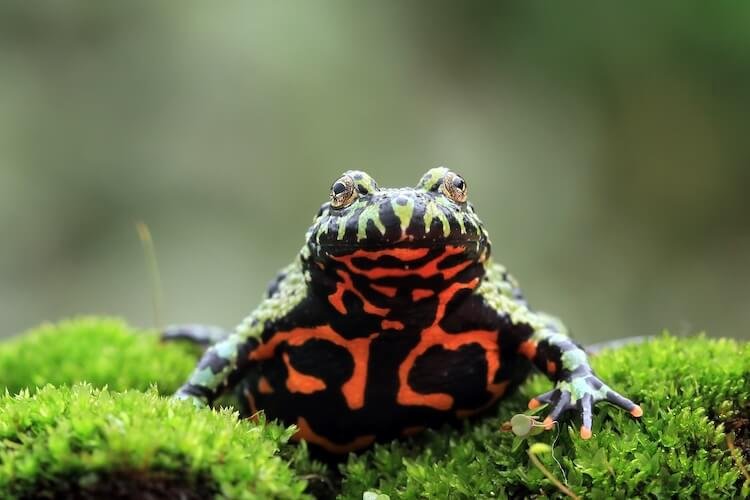
Facts About Fire-Bellied Toad
| Characteristic | Detail |
| Origin | China, Korea, Russia |
| Size | 2-2.5 inches |
| Lifespan | 10-15 years |
| Diet | Carnivorous; mainly eats insects like crickets, worms, and small invertebrates |
| Behaviour | Social, often kept in groups, active during the day |
| Special Features | Bright red/orange belly for warning predators |
| Tank Requirements | Minimum 10 gallons, half water, half land setup, water temperature 72-78°F |
Care Level: Easy
Habitat: They need a terrarium with both land and water areas and plenty of places to hide.
3. African Dwarf Frog (Hymenochirus boettgeri)
These tiny frogs are fully aquatic and are often seen in home aquariums. African Dwarf Frogs are playful and enjoy swimming around. They are social and do well in groups, making them a lively addition to your tank.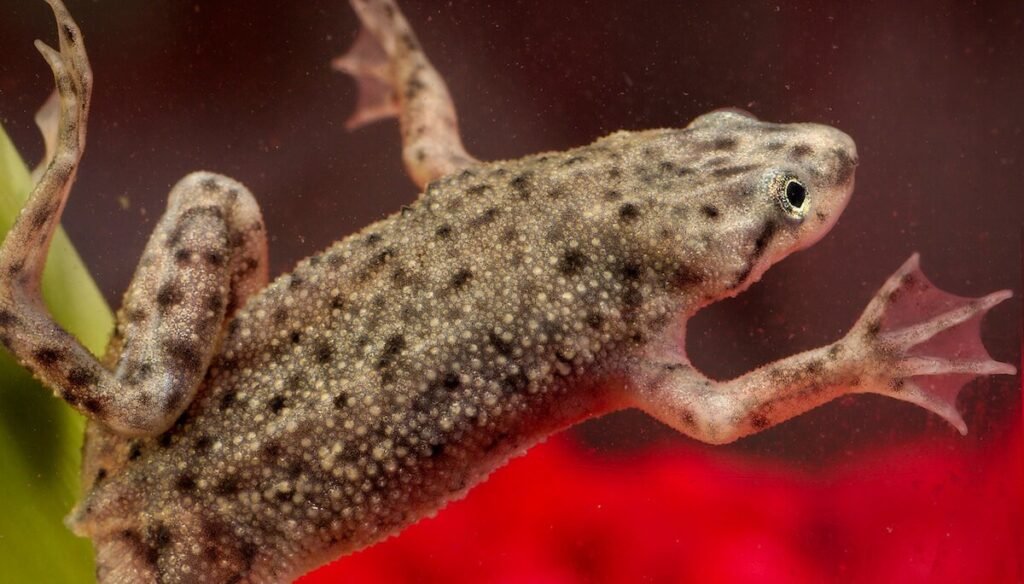
Facts About African Dwarf Frog
| Characteristic | Detail |
| Origin | Central Africa |
| Size | 1.5 inches |
| Lifespan | 5-10 years |
| Diet | Carnivorous; eats small aquatic invertebrates, bloodworms, and brine shrimp |
| Behaviour | Peaceful, social, best kept in groups |
| Special Features | Fully aquatic, enjoys swimming and exploring the tank |
| Tank Requirements | Minimum 5 gallons, water temperature 72-78°F, gentle filtration |
Care Level: Easy
Habitat: A well-maintained freshwater aquarium with gentle filtration and plenty of plants.
4. Pacman Frog (Ceratophrys ornata)
Named after the video game character because of its big, round mouth, the Pacman Frog is an ambush predator that eats anything that fits in its mouth. Their bright colours and unique feeding habits make them popular among amphibi anenthusiasts.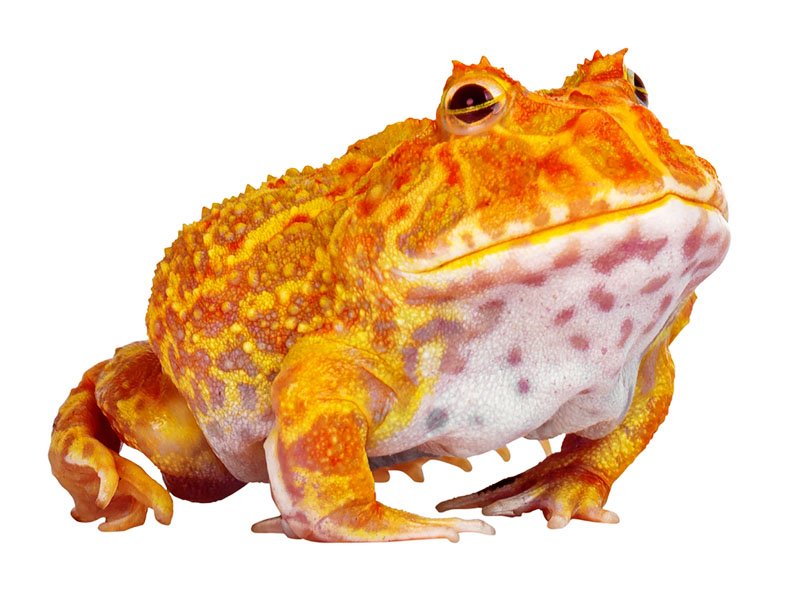
Facts About Pacman Frog
| Characteristic | Detail |
| Origin | South America |
| Size | 4-7 inches |
| Lifespan | 6-10 years |
| Diet | Carnivorous: eats insects, small rodents, and even other frogs |
| Behaviour | Ambush predator spends most of the time buried in the substrate |
| Special Features | Large, round mouth, can eat prey nearly as large as itself |
| Tank Requirements | Minimum 10 gallons, moist substrate, humidity 60-80% |
Care Level: Moderate
Habitat: A simple, moist terrarium with soft bedding and minimal decorations. They like to bury themselves and wait for food.
5. Red-Eyed Tree Frog (Agalychnis callidryas)
The Red-Eyed Tree Frog is famous for its bright green body, striking red eyes, and colourful sides. These frogs are beautiful and known for their acrobatic jumps and nighttime activities.
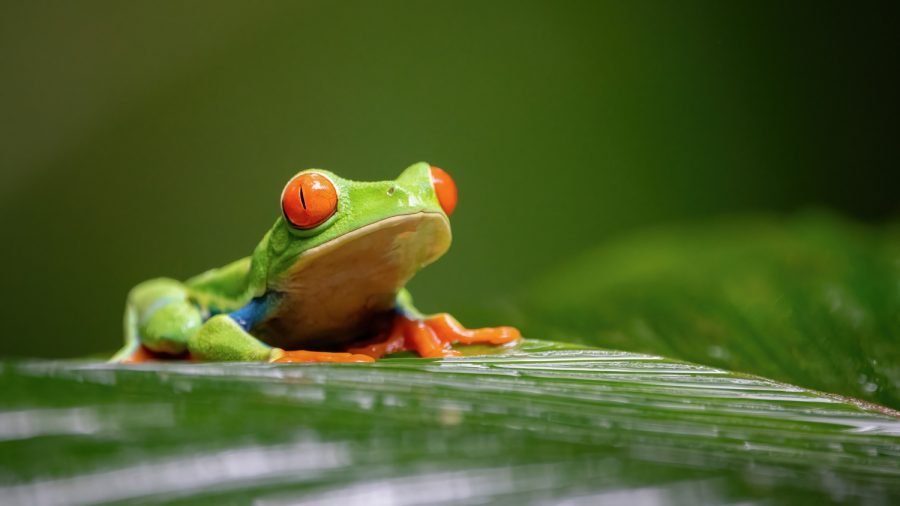
Facts About Red-Eyed Tree Frog
| Characteristic | Detail |
| Origin | Central and South America |
| Size | 2-3 inches |
| Lifespan | 5-10 years |
| Diet | Insectivorous; mainly eats crickets, flies, and moths |
| Behaviour | Nocturnal, arboreal, prefers to stay high in the trees |
| Special Features | Bright red eyes, vivid green body, blue and yellow flanks |
| Tank Requirements | Minimum 20 gallons, vertical setup, humidity 70-90%, temperature 75-85°F |
Care Level: Moderate
Habitat: A tall terrarium with plenty of vertical space, plants, and a water source to mimic their natural habitat.
6. Tiger Salamander (Ambystoma tigrinum)
Tiger Salamanders are some of the largest land-dwelling salamanders, with bold stripes that give them their name. They are hardy and can be quite friendly, especially when they recognise their owners as a food source.
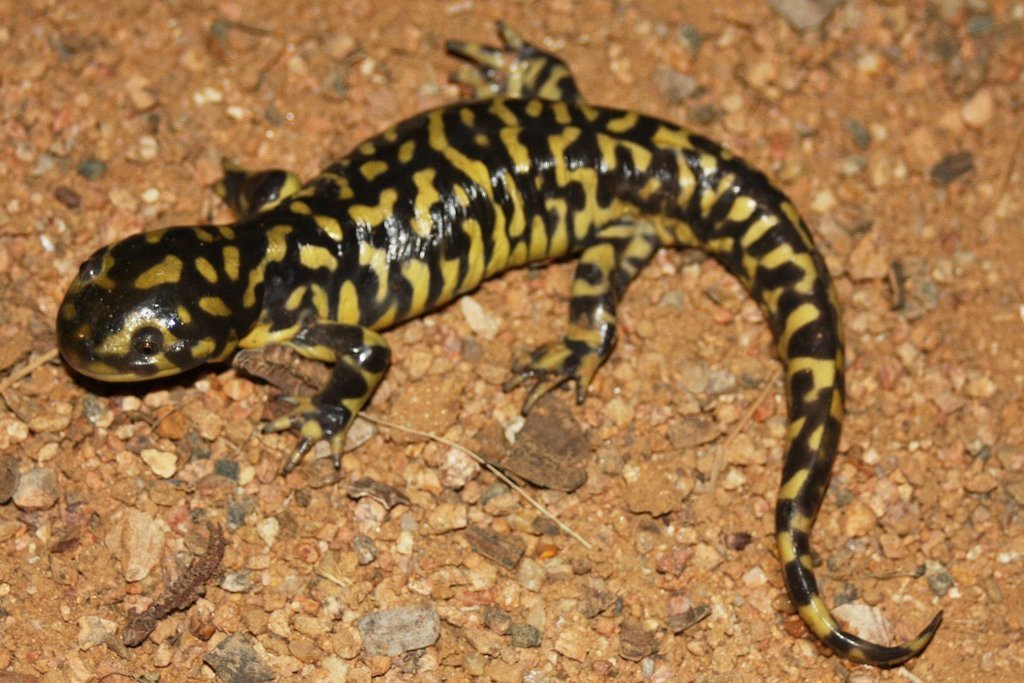
Facts About Tiger Salamander
| Characteristic | Detail |
| Origin | North America |
| Size | 6-13 inches |
| Lifespan | 10-15 years |
| Diet | Carnivorous; eats insects, worms, and small invertebrates |
| Behaviour | Burrowing, active at dusk and dawn |
| Special Features | Bold yellow or olive stripes on a black body, hardy and interactive |
| Tank Requirements | Minimum 20 gallons of moist substrate for burrowing, hides and plants |
Care Level: Easy
Habitat: A large, moist terrarium with many hiding places and bedding that allows them to burrow.
7. White’s Tree Frog (Litoria caerulea)
Also known as the Dumpy Tree Frog, White’s Tree Frog is known for its chubby body and calm nature. These frogs are very hardy, making them a great choice for beginners. They are also docile and can even be gently handled.
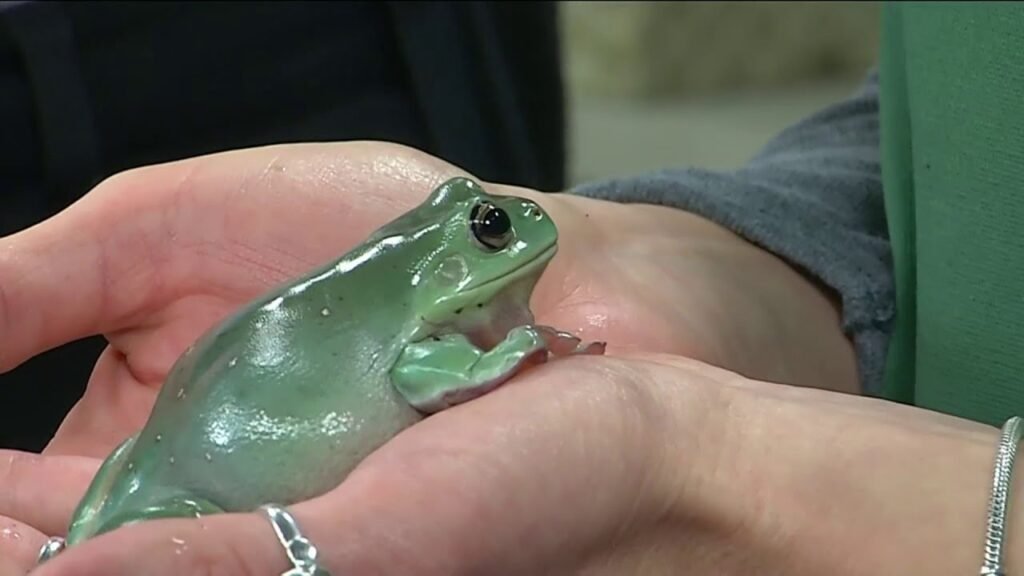
Facts About White’s Tree Frog
| Characteristic | Detail |
| Origin | Australia, New Guinea |
| Size | 3-4.5 inches |
| Lifespan | 10-20 years |
| Diet | Insectivorous; eats crickets, moths, and small invertebrates |
| Behaviour | Docile, tolerant of handling, nocturnal |
| Special Features | Chubby appearance, blue-green skin, waxy coating to prevent water loss |
| Tank Requirements | Minimum 15 gallons, vertical setup with branches, humidity 50-60%, temperature 75-85°F |
Care Level: Easy
Habitat: A simple terrarium with branches, plants, and a water dish. They enjoy climbing and need vertical space.
8. Eastern Newt (Notophthalmus viridescens)
The Eastern Newt has a fascinating life cycle, including a bright red “eft” stage when it lives on land before returning to the water as an adult. They are small and hardy and change colour throughout their lives, making them fun pets.
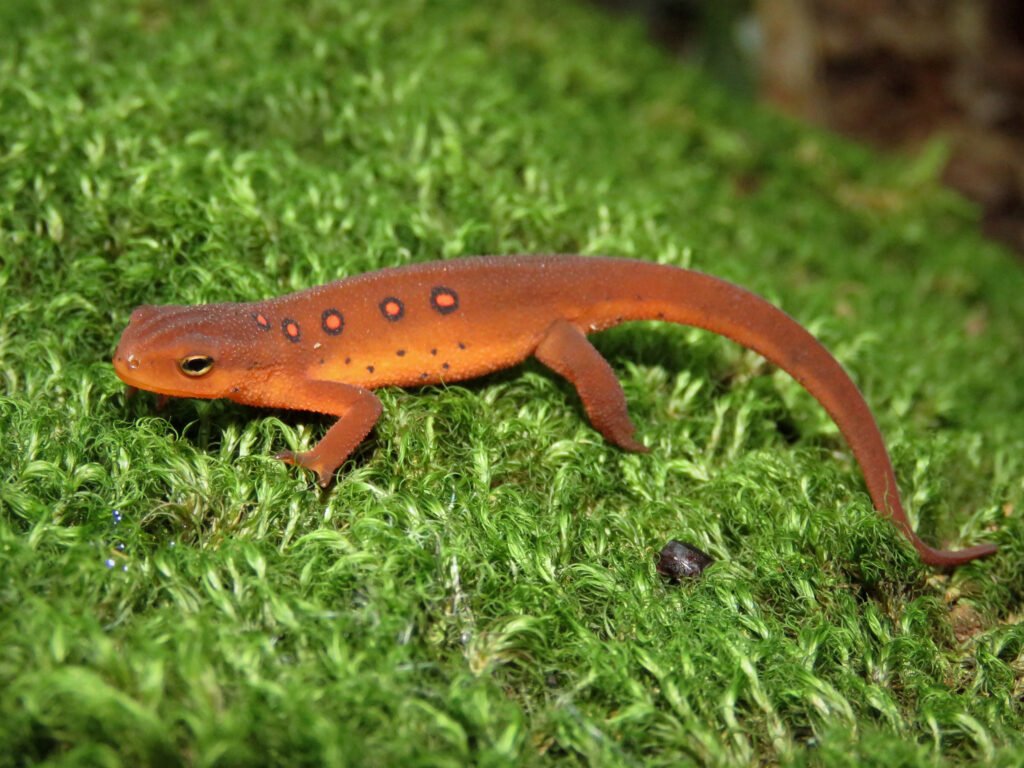
Facts About Eastern Newt
| Characteristic | Detail |
| Origin | Eastern North America |
| Size | 2.5-4 inches |
| Lifespan | 12-15 years |
| Diet | Carnivorous; mainly eats small invertebrates, worms, and insects |
| Behavior | Semi-aquatic, active during the day, goes through a land-dwelling “eft” stage |
| Special Features | Bright orange-red during the eft stage, changes colour when returning to water |
| Tank Requirements | Minimum 10 gallons, semi-aquatic setup with both land and water areas, temperature 60-75°F |
Care Level: Moderate
Habitat: A setup with both land and water areas, plants, and places to hide.
9. Green Tree Frog (Hyla cinerea)
The Green Tree Frog is a small, vibrant amphibian with a loud call. They are popular amphibian pets because they are easy to care for and have a charming appearance.
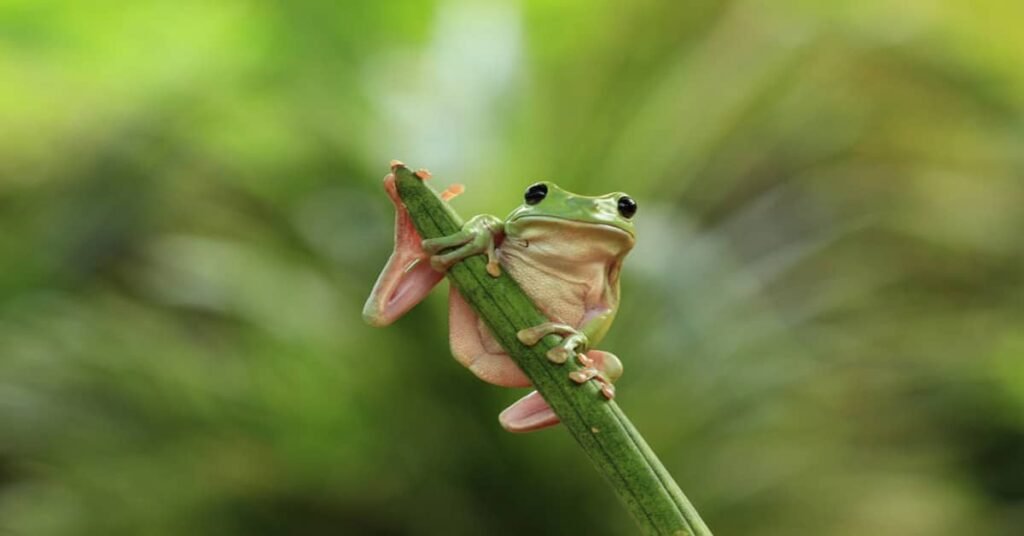
Facts About Green Tree Frog
| Characteristic | Detail |
| Origin | Southeastern United States |
| Size | 2-2.5 inches |
| Lifespan | 5-8 years |
| Diet | Insectivorous; eats crickets, flies, and moths |
| Behavior | Nocturnal, arboreal, likes to climb and perch on leaves |
| Special Features | Bright green colour, loud call during mating season |
| Tank Requirements | Minimum 10 gallons, vertical setup with branches, temperature 70-80°F |
Care Level: Easy
Habitat: A vertical terrarium with branches, leaves, and a small water source.
10. American Bullfrog (Lithobates catesbeianus)
The American Bullfrog is the most giant frog in North America and is known for its deep, resonant croak. It is hardy and can be quite impressive as a pet, though it requires a lot of space.
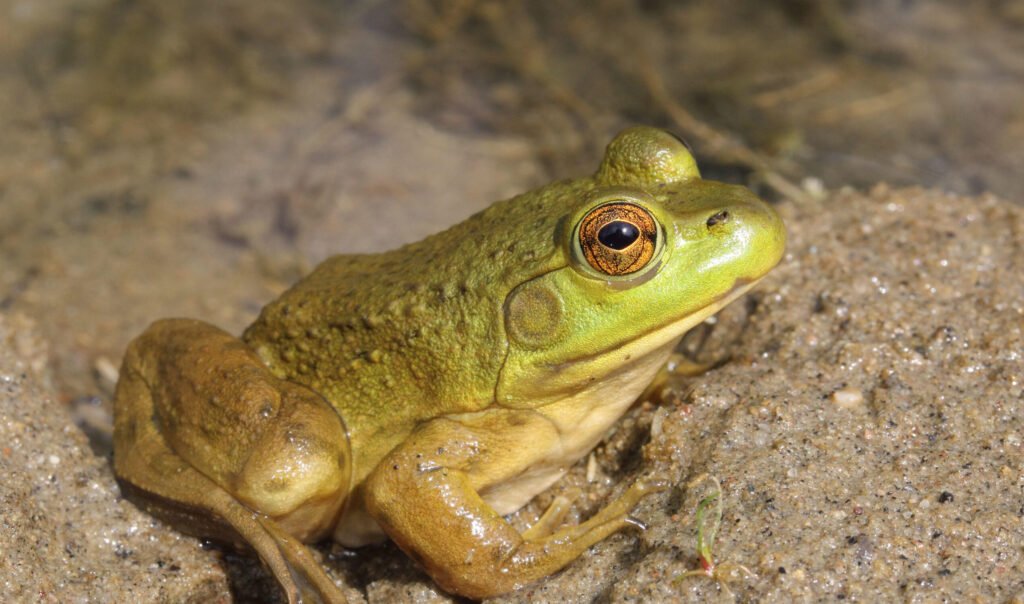
Facts About American Bullfrog
| Characteristic | Detail |
| Origin | North America |
| Size | 6-8 inches |
| Lifespan | 7-9 years |
| Diet | Carnivorous: eats insects, small rodents, birds, and other amphibians |
| Behavior | Territorial, nocturnal, very active at night |
| Special Features | Deep croak, large size, voracious appetite |
| Tank Requirements | Minimum 30 gallons, semi-aquatic setup with both land and water areas, temperature 75-85°F |
Care Level: Difficult
Habitat: Requires a large terrarium with both water and land areas, as well as hiding spots.
Conclusion
Amphibians can be fantastic pets for those willing to meet their specific needs. From the hardy Axolotl to the vibrant Red-Eyed Tree Frog, each species offers something unique. Understanding their care requirements, habitat needs, and behaviours will ensure your new amphibian friend’s happy and healthy life.


